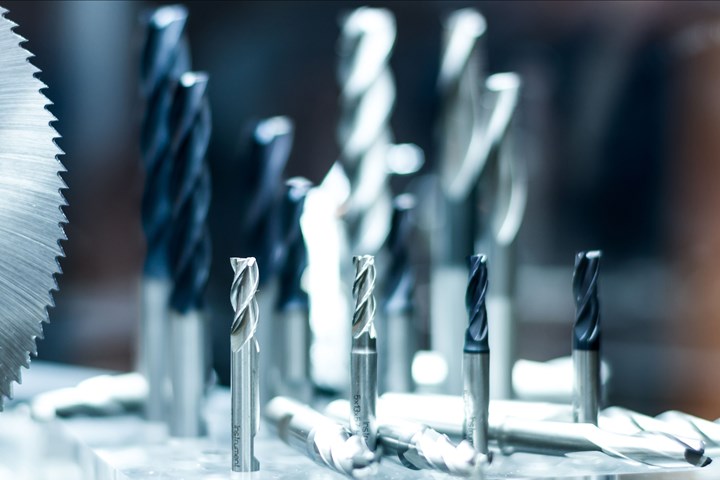Considerations for Properly Implementing Advanced Tool Materials
Many shops incorrectly assume advanced tools are plug and play. The tools may fit into existing tool holders, or even into the same shell mill pockets or turning pocket as carbide inserts, but that’s where the similarities end.
Reader Question:
Other than HSS taps, our current tool inventory is all carbide and we’ve settled on some satisfactory grades and coatings for our applications. We are open to exploring more advanced tool materials like PCD but need some guidance on justifying the cost and secondary considerations. How do you view these and justify their fit in your processes?
Miller’s Answer:
We often forget how adaptable carbide can be given its interchangeable nature in typical systems, whether it be end mills, shell mill inserts or turning inserts. When we want a process improvement, we can simply reach for a new geometry, flute count or coating and off we go, often with minimal changes needed or cost added. However, as part requirements become more difficult, we may reach the upper end of carbide’s capability, which is where advanced tool materials like polycrystalline diamond (PCD), monocrystalline diamond (MCD), cubic boron nitride (CBN) and ceramic come into play. Sometimes called “exotics”, these can be a very exciting addition to any process, but the cost justification and the process adaptations require careful consideration.
|
Type |
Cost-to-carbide equivalent |
Applications |
|
PCD – Polycrystalline Diamond |
10X |
Nonferrous roughing and finishing |
|
SCD – Single Crystal Diamond |
20X |
Nonferrous ultra-fine finishing |
|
CBN – Cubic Boron Nitride |
10X |
Ferrous roughing and finishing |
|
Ceramic – Alumina or Silicon Nitride |
3X |
HRSA roughing |
To understand where they all fit, let’s start with a simple approach. Most cutting processes fall into two buckets: roughing or finishing. To put it more specifically, is the task in question to move metal out of the way, or is the task to put down a smooth, accurate surface?
If roughing is identified as an area for improvement, then a simple comparison of metal removal rates for your current process and one with an exotic is appropriate. From there, you can extrapolate this for total machine time saved for the year and apply the burden rate. Is the added cost of the tool amortized with the savings? If so, then it’s probably a winning application for an advanced tool.
For finishing, a deeper look at the overall project requirements may be required. A new, sharp, carbide tool can make incredible finishes when setup properly and with the right parameters; however, where advanced materials shine is their ability to achieve an even better finish while also maintaining this finish over long part runs due to their enhanced wear resistance. Therefore, a prototype application may be fine with a traditional carbide tool, knowing only a short run of parts are needed. A production application may view this differently when looking at runs of 1000 or more parts. In this case, the justification is simple, as it’s a must have to meet customer requirements.
Beyond the more obvious justifications above, there are others worth a look for your shop. In the case of PCD and CBN, tool manufacturers often make these tool materials available for existing turning and shell mill insert pockets, which means there is no added cost for durable tooling. This decreases the barrier and cost of entry and enables your shop to experiment before investing in more dedicated tool inventory.
In the case of shell mills, we may only need to dedicate a single pocket to the use of diamond or CBN. A single wiper insert is often enough to leave the desired finish while the rest of the inserts are traditional carbide. Now the cost of that single insert, even at 10X, can be amortized over a greater part of the total tool assembly cost.
Lastly, another benefit for PCD and CBN is their ability to do roughing and finishing duties. You may be able to replace two tool assemblies in a process with a single tool, which saves tool cost, but will also improve overall process efficiency and cycle time.
One thing shops may get wrong when getting into advanced tooling is incorrectly assuming these tools are plug and play. The tools may fit into existing tool holders, or even into the same shell mill pockets or turning pocket as carbide inserts, but that’s where the similarities end. Advanced tooling runs at higher surface speeds which means more rpm and more heat. These tools are also more brittle.
Tool holders need more care for balance and runout to accommodate the elevated speeds and reduce vibration. Also, the way we enter and exit a cut can hurt the insert, so take some time to revisit your toolpaths and programming to ease into things.
Coolant systems also need to be equipped for success. A single coolant nozzle lightly splashing the cutting tool will no longer suffice, so make sure the volume and pressure are adequate for the application. In the case of ceramics, we need to make sure we’re working in a very dry environment to not shock the tool.
With all these enablers, make sure you are accounting for these upgrades with your overall cost model for advanced tooling. You could miss key cost adders during implementation, or realize you need to make this a longer-term improvement project, investing over time with holders, a coolant system and then finally the advanced tools. A thorough understanding of the required adaptations from the supporting cast — process and people alike — are the secret to unlocking any exotic’s full potential.
One quick point is that most of the above tool materials can be incorporated into abrasive tooling as well. If a traditional chip-making process cannot achieve what you need, an abrasive process may be an option. However, the above comments about tool holders and coolant systems are amplified even more with abrasives, including the need for a machining center with properly sealed guideways and coolant filter system to resist the new grit in the process.
As shops and businesses, we must manage money in and money out. The added cost of more advanced tool materials often will reap benefits long term, but can also unlock new capabilities for finish and consistency that your shop didn’t previously have. Be sure to review the full picture and not get caught up in sticker shock.
Related Content
Buying a Lathe: The Basics
Lathes represent some of the oldest machining technology, but it’s still helpful to remember the basics when considering the purchase of a new turning machine.
Read MoreNew Machining Technology Works With Old to Restore WWII Submarine
A set of donated boring bars that can be used in a 1954 boring head will enable volunteer machinists to recreate a pair of binoculars for the USS Pampanito.
Read MoreQuick-Change Tool Heads Reduce Setup on Swiss-Type Turning Centers
This new quick-change tooling system enables shops to get more production from their Swiss turning centers through reduced tool setup time and matches the performance of a solid tool.
Read MoreA New Milling 101: Milling Forces and Formulas
The forces involved in the milling process can be quantified, thus allowing mathematical tools to predict and control these forces. Formulas for calculating these forces accurately make it possible to optimize the quality of milling operations.
Read MoreRead Next
The Cut Scene: The Finer Details of Large-Format Machining
Small details and features can have an outsized impact on large parts, such as Barbco’s collapsible utility drill head.
Read MoreObscure CNC Features That Can Help (or Hurt) You
You cannot begin to take advantage of an available feature if you do not know it exists. Conversely, you will not know how to avoid CNC features that may be detrimental to your process.
Read More3 Mistakes That Cause CNC Programs to Fail
Despite enhancements to manufacturing technology, there are still issues today that can cause programs to fail. These failures can cause lost time, scrapped parts, damaged machines and even injured operators.
Read More














.png;maxWidth=300;quality=90)




.png;maxWidth=300;quality=90)











